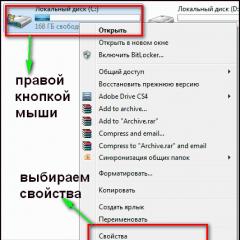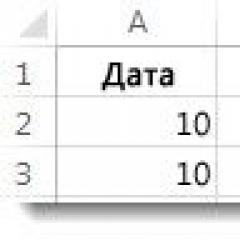What file system to format the flash drive. In what format to format a flash drive: the optimal choice of the NTFS or FAT32 file system: which one to prefer
Updated - 2017-01-25
What file system to format the flash drive. Almost everyone knows what a flash drive is. Now it is simply impossible to do without this carrier of information. Wherever it is used, and in computer technology, and in cameras, and in camcorders, and in electronic books, and digital signatures in electronic document management, and so on and so forth. And such a thing is quite affordable for everyone. But today we will talk about a computer flash drive, or as it is popularly called - a flash drive.
For some, it simply serves to transfer files from computer to computer, for someone it is already a whole range of programs for installing operating systems, testing computer components and programs. Someone uses a flash drive to watch videos, someone records video tutorials using the same flash drive, someone launches their favorite toys and customized office programs from it. And for all this, you just need to properly format the USB flash drive, otherwise you will not be able to store large files on it. For comfortable work with a flash drive and for different purposes, you must use a different file system. What kind of file system should be used in this or that case, we will talk with you now.
The most relevant file systems for flash drives and other external media are FAT32, NTFS and exFAT.
We will not go into theory, but simply determine how good this or that file system is for our purposes. Then you just need to format your flash drive in the system that suits you.
FAT32 faster than NTFS and exFAT and is suitable for you if you transfer small files from computer to computer - up to 4 GB. These are files of a text editor Word, Excel, photos, and small (again up to 4 GB) videos.
Same way FAT32 necessary if you are viewing files from a flash drive on a TV, DVD, auto FM modulator. Some TVs and DVDs simply don't see the other system. There's nothing to be done here.
But the system FAT32 there are also disadvantages. It is less reliable than NTFS. What is this unreliability? The fact is that if an unexpected power outage of the computer occurs, or you did not correctly remove the USB flash drive from the connector, then your data may simply disappear from it or not open again.
Therefore, if you are sure that you will not have to watch videos on older devices, then the USB flash drive in the system NTFS.
And if you intend to store large files, photos and video films on a flash drive, then it is better to use the system exFAT. For example, memory cards in cameras and video technology use just such a system. In this case, these systems provide optimal speed.
Usually, if writing is faster, then reading files is slower, and vice versa. Therefore, when choosing a file system, you can focus only on the use of a flash drive in one case or another:
- For large files, more than 4 GB - NTFS,
- For graphics - exFAT,
- To view photos and small movies on older TVs and DVD players - FAT32.
Now you know what file system to format the flash drive with, so you can avoid many problems when working with it.
Video clip Which file system to format the flash drive:
A USB flash drive, much more commonly referred to as just a flash drive, is a very convenient and currently popular way to store and transfer data. As a rule, flash drives sold in stores are formatted in the FAT32 file system. The explanation for this is simple: all operating systems support FAT32. If for some reason you need to format the flash drive again, you can decide for yourself in which format to format the flash drive: ext4, FAT32 or NTFS. In this review, we will look at the disadvantages and advantages of each file system.
Ext4
This format is not supported by Windows, so you should only use ext4 if your computer is running Linux and you don't need to transfer data to Windows computers. In my opinion, the coincidence of these two conditions does not happen too often.
FAT32
The advantages of FAT32 include not only compatibility with all operating systems, but also a high data transfer rate for relatively small files. However, this file system does not work with files larger than 4Gb and loses its performance with high file fragmentation, as well as with a large number of files in the directory. Another limitation is that a FAT32 directory cannot contain more than 65534 files (although how often do you have to deal with that many files?). In general, if in doubt in which format to format the USB flash drive, choose FAT32.
NTFS
The NTFS file system provides fairly high performance when working with both large and small files, however, its average data transfer rate is lower than that of FAT32. The main advantage of NTFS is the high reliability of saving data from failures. Unfortunately, this system is not supported by Windows95, Windows98 and WindowsME.
Today, flash drives are called both ordinary removable USB media and memory cards for mobile devices. They are used everywhere. But sometimes, for the first use or restoration of the operability of such devices, the media must be formatted. This is where a completely logical question arises - in what format to format a USB flash drive? Let's take a look at some of the main options and compare their advantages and disadvantages.
Factors affecting which format is better to format a USB flash drive
Before proceeding with formatting, it should be clearly defined for what purposes the drive will be used, and what kind of information will be stored on it.
In this case, special attention should be paid to the question - in which operating system the device will be used. In addition, even with a huge number of tools for reading and writing information on modern USB drives, the size of its built-in memory has a fairly strong influence on the solution of the problem of what format to format a USB flash drive in.
NTFS or FAT32: which do you prefer?
As a rule, almost all current Windows systems offer several options when choosing a file system for formatting removable media, but NTFS and FAT32 standards can be distinguished among the main ones.

Here you should immediately evaluate the amount of memory of the device. FAT32 can only work with devices whose memory capacity does not exceed 4 GB. Modern models of such USB devices have much larger volumes. Therefore, when deciding in which format to format a flash drive, it is from the point of view of this aspect that you should definitely choose NTFS.
On the other hand, the problem also has a downside. For example, when trying to use the device on some modern TV panels, PS3 or Xbox, the NTFS system may not be recognized.
The same applies to creating bootable media for installing Windows systems on computers and laptops, in which instead of the standard BIOS I / O system, an improved UEFI development is used, which the NTFS file system standard also does not recognize. Thus, the conclusion suggests itself quite obvious: formatting should be done in FAT32.
Ext4 format
Sometimes you can meet the Ext4 standard. However, it is used mainly exclusively in Linux systems. If the user works with one of these modifications and does not plan to transfer data from the drive, for example, to computers with Windows systems that do not recognize this format, it can be used. Otherwise, you will again have to choose between FAT32 and NTFS.
In what format to format a flash drive for Android
Now a few words about removable drives in the form of SD cards, which are used in mobile Android devices. Since operating systems of this type do not support NTFS to the slightest extent, this formatting option can be excluded immediately.

You will have to choose between FAT32 and exFAT. Here again, initially the question rests on the amount of memory of the drive. It is clear that with volumes of more than 4 GB, the issue is unambiguously resolved in favor of exFAT. It was possible, of course, to use systems like Ex2 / 3/4, but the problem here is that such formats are mostly perceived not by standard, but by custom Android firmware, and when formatted in Ex4, Windows systems can only read information from the drive, but do not write down.
Brief summary
Thus, rush possible in two ways. Despite the fact that the FAT32 system cannot work with large amounts of memory, it functions somewhat faster than NTFS, and, moreover, is recognized by almost all known operating systems and devices. But NTFS is preferable for more than 4 GB of memory.
For Android, a universal solution is to use the exFAT system, which simultaneously combines almost all the features and advantages of both FAT32 and NTFS.
Hello dear friends! Today we will talk with you about the format in which to format a USB flash drive. The fact is that there are certain nuances that I think you should be aware of.
In what format to format the flash drive
So, first of all, we should decide how we will use a USB flash drive or an external hard drive. This will immediately clear up a lot.
Flash drive options:
- The flash drive stores various files necessary for work;
- A flash drive or external HDD is used as a multimedia data storage;
- Music or movies are recorded on a flash drive for playback on third-party devices.
Let's go through the points in more detail. The situation on the first point is characterized by the fact that you often have to use a flash drive on different computers.
Often there is no way to understand whether there are viruses on these computers. Therefore, you need to protect the data on such flash drives yourself, and it is advisable to do this in advance.
By the way, I have good news for you! The site already has an article about protecting a flash drive from viruses (I can say that it is highly valued on the Internet),.

Regarding our question, I can say that an important step in installing protection on a USB flash drive is formatting it in NTFS format.
Point number two: the flash drive is used as a storage for various data. As you probably know, the FAT32 file system has file size limits. The file cannot be larger than 4 Gb. Nowadays, this is not so much, considering that there are various video formats or virtual dual-layer discs.
Often there are disk images of 8 Gb each, not to mention films of 40 Gb or more in Bluray or 3D format.
It is quite obvious that for such purposes the FAT32 file system is clearly not enough for us. We considered another option in favor of the NTFS file system for a flash drive.
So what about FAT32? It's too early to bury this file system.
Firstly, there are operating systems that do not support the NTFS format, this is a rarity in our time, but nonetheless.
Another situation is much more common: we have a car, it has a radio tape recorder. This radio does not want to read songs from a flash drive. But after formatting to the FAT32 system, the radio tape recorder begins to interact perfectly with the flash drive.
Also, the FAT32 file system may require some TVs, media players and other devices such as PS3 or xBox set-top boxes.
Conclusion
Having understood for what purposes the flash drive will be used, we ourselves will be able to answer the question in what format to format. It is clear that more often, in the vast majority of cases, it will be more convenient to use an NTFS flash drive.
But in particular cases, there is simply no alternative to flash drives with FAT32, so many people still use this file system.
Flash drives (flash drives) have simply become an indispensable part of the digital world. Now each user has a flash drive instead of a key fob. From year to year, USB drives change shapes and sizes, properties and volumes, and it is already difficult to surprise anyone with a 32 GB flash drive when there are 128 GB models in free sale stores!
Like any electronic device, a flash drive has a "main" function - to fail. Most often, flash failures are related to the file system in which the devices are formatted. There are often cases in which a USB drive, when connected to a computer, issues a critical notification that this disk needs to be formatted! This problem is very difficult to fix and it remains only to format the flash drive.
What file system should I format my flash drive with?
Let's start with the fact that we will determine the type of file system. The priority choice for today can be considered: NTFS and FAT 32.
The main thing here is to understand the positive qualities of each of these systems. So if you need to format a flash drive larger than 16 GB, then the choice will most likely fall on NTFS. Let me explain why, this file system has some advantage compared to FAT 32, it allows you to upload large files to the drive. It will be useful for users who use the transfer of media content, in particular large video files (movies in HD quality).
A small disadvantage is the mandatory use of the “safely remove devices” function, since the NTFS file system has a caching property and, if it is turned off abruptly, the stored data may fail or be damaged. That is why users are afraid of power outages in their homes, as computer hard drives are formatted in the NTFS system, which can make it difficult to restart the operating system, up to the loss of personal data!
If you are using a small USB flash drive to transfer office documents or graphic information, then it will be sufficient to format the USB drive to the standard FAT 32 system (FAT, exFAT).
Any of the two systems can be installed using standard tools of the Windows operating system. Thanks to modifications in Windows 7, the NTFS file system has also become available!
Note! It is worth remembering that in the process of formatting a flash drive, all available information will be permanently deleted! First make sure that important data will not be lost!
How to format a USB flash drive?
- Connect the USB drive to the computer port. Allow time for the device to be detected by the operating system.
- After that, the “Autorun” window or a notification about the impossibility of access may appear, it all depends on the individual case that led to the need for formatting!
- Close the windows that appear, go to the "Computer" directory (key combination Win + E or Desktop icon).
- find your flash drive among the "removable drives" section, but do not open it!

- Click on the flash drive shortcut with the right mouse button and find the "Format" context menu item, activate by pressing the left button.
- A formatting window will appear (as shown in the figure below).

- In order from top to bottom, check the set formatting options
- Capacity - a value showing the total capacity of the selected flash drive.
- File system – select the type of file system for the selected device (FAT 32 is the default).
- Cluster size - the value is set either automatically or from the list (Preferably - "Standard cluster size").
- Restore default settings - the button to reset the set values above.
- Volume label - name - character value, is intended to indicate the individual name you use for the device in addition to the drive letter you specify.
- Quick cleaning of the table of contents - an optional item, but preferable when formatting flash drives larger than 16 GB, this item makes the formatting go much faster - "Quick Format".
- Start - The button at the bottom of the window is intended to start the formatting process using the values set above.
- After the value of the points are chosen, click the button “Start.

- Confirm the continuation of formatting in the notification that appears and wait a few seconds.

- After that, a notification will appear about the successful completion of formatting!
Instead of an afterword
The formatting process is not complicated and is performed by standard means of operating systems. As mentioned above, changing the file system is not only a simple process, but also increases functionality.
And if you change the “Volume Label”, then your device will also acquire a personal, unique character. But despite the simplicity and entertaining process of formatting a flash drive, I want to wish you not to know any problems in the operation of your little computer assistant!



